
Chaldean Catholic Eparchy of Amadiya (or Amadia) was a historical eparchy (diocese) of the Chaldean Catholic Church, [1] until it was united with the Chaldean Catholic Eparchy of Zakho in 2013.

Chaldean Catholic Eparchy of Amadiya (or Amadia) was a historical eparchy (diocese) of the Chaldean Catholic Church, [1] until it was united with the Chaldean Catholic Eparchy of Zakho in 2013.
The diocese was established on 1785 and named for the hilltop city of ʿAmadiya in northern Iraq.
It lost territory in 1850 to establish the eparchies (dioceses) of Aqrā and Zaku (Zākhō), but on 23 April 1895 it regained territory from the suppressed daughter-diocese of Aqrā, yet on 24 February 1910 it lost territory again to re-establish the eparchy of Aqrā.
In 1913 it included ʿAmadiya city itself and sixteen villages in the Tigris plain near the town of Dohuk and in the Sapna and Gomel river valleys.
On 10 June 2013 it was renamed as Diocese of Amadiyah and Zaku or Amadia and Zākhō, having gained territory from the suppressed daughter-eparchy of Zaku.
There were three main concentrations of East Syriac villages in the ʿAmadiya region: in the Sapna valley to the west of ʿAmadiya, in the Tigris plain around Dohuk, and in the Shemkan district, around the valley of the Gomel river. Before the fourteenth century the Sapna valley was part of the diocese of Dasen and Beth Ture ('the mountains'), which lay to the north of Marga and also covered the Berwari region and the Zibar and Lower Tiyari districts. The villages in the Dohuk district were included in the East Syriac diocese of Beth Nuhadra, whose bishops resided in the small town of Tel Hesh near Alqosh, and those in the Gomel valley in the diocese of Marga, centred on the ʿAqra region. The last-known bishops of Beth Nuhadra and Dasen, Ishoʿyahb and Mattai, were present at the consecrations of Makkikha II in 1257 and Yahballaha III in 1281 respectively, and it is unclear when either diocese came to an end.
No bishops of the ʿAmadiya region are known from the fourteenth and fifteenth centuries. After the schism of 1552 the region remained loyal to the Nestorian patriarch Shemʿon VII Ishoʿyahb, and his opponent Yohannan Sulaqa, the first Chaldean patriarch, was martyred in 1554 after an attempt to win over ʿAmadiya's East Syriac community. Thereafter the region seems to have been claimed by both patriarchates for some decades. A metropolitan ʿAbdishoʿ of 'Koma', probably the Sapna village of Komane with its recently revived monastery of Mar ʿAbdishoʿ of Kom, was among the signatories of a letter of 1580 from Shemʿon IX Denha to pope Gregory XIII, and the Dasen district was claimed by the Qochanes patriarch Shemʿon XI in 1653. On the other hand, a bishop Abraham of Beth Ture ('the mountains') is mentioned among the hierarchy of Eliya VII (1591-1617) in the report of 1610. Given its proximity to Alqosh, it would be surprising to find the region under the influence of the Qudshanis patriarchs, and the surviving manuscripts copied for the Dohuk, Sapna and Shemkan villages (some originating from Gazarta but the majority from Alqosh) invariably mention patriarchs of the Eliya line. By the end of the eighteenth century the Mosul patriarchate had a diocese of ʿAmadiya for the region.
Patriarch Eliya XII (1778-1804) consecrated his nephew Hnanishoʿ metropolitan of ʿAmadiya in September 1784 after his withdrawal to ʿAmadiya, with the intention of preserving the patriarchal succession within his family. Hnanishoʿ made a Catholic profession of faith in 1795, but was felt by the Latin missionaries to be insincere. In 1801 the Vatican informed them that he could not be received as a bishop in the Catholic Church without 'manifest signs of penitence'. Shortly afterwards in the same year Hnanishoʿ openly defied the Vatican, consecrating the priest Peter Shawriz metropolitan of Seert.
Hnanishoʿ seems to have become reconciled with Yohannan Hormizd after the death of Eliya XII in 1804, as in 1808 he was living in his household in Alqosh. He was 'senior to Yohannan, and governed the diocese of ʿAmadiya, but all the same could do nothing without the approval of the metropolitan Yohannan'. Although he sympathised with Gabriel Dambo's monastic order, his dependence on Yohannan Hormizd occasionally forced him to act against his better judgement. In 1808 he asserted himself by delivering the monastery of Rabban Hormizd to Gabriel Dambo in defiance of Yohannan Hormizd's wishes. In 1811, however, on Yohannan Hormizd's instructions, he 'became a Nestorian at ʿAmadiya' and expelled Dambo and his monks from the monastery with the assistance of the civil authorities. In 1813 he fell mortally ill, and made amends for his harsh treatment of the monks on his deathbed by returning the keys of the monastery to them. He died shortly afterwards and was buried in the monastery of Rabban Hormizd, 'among the tombs of the patriarchs of the Nestorians'.

Some years earlier a Catholic diocese had been established in the region with the consecration by Yohannan Hormizd of his nephew Mattai Shemʿon for ʿAmadiya on 5 May 1790. Shemʿon, originally named Yohannan, was the son of Yohannan's brother the priest Giwargis, and appears to have been consecrated on the suggestion of the missionary Maurizio Cherzoni. There is no need to doubt the sincerity of Yohannan Hormizd's commitment to the Catholic faith at this period, but the appointment was of course also directed against his rival Eliya XII (1778-1804). After his consecration Shemʿon made a determined effort to convert a number of villages in the Sapna plain and the Zibar district to Catholicism. [2] He was killed by brigands not far from the Great Zab in 1811.
Basil Asmar of Telkepe, a monk of the monastery of Rabban Hormizd, was consecrated for ʿAmadiya at Amid by the patriarchal administrator Augustine Hindi in April 1824, but seems to have had no contact with his diocese. He resided in his home village of Telkepe until 1827, apparently in fear of the governor of ʿAmadiya, known to be a friend of Yohannan Hormizd, and in 1827 fled to Amid, becoming its metropolitan in 1828.
Basil Asmar was succeeded as metropolitan of ʿAmadiya in 1830 by the energetic Joseph Audo, who was transferred from Mosul to the diocese of ʿAmadiya under the settlement which confirmed Yohannan VIII Hormizd as patriarch and ended the schism in the Chaldean Church. During his metropolitanate Audo converted many of the villages of the Sapna valley to Catholicism. After he became patriarch in 1848 he was succeeded as metropolitan of ʿAmadiya in 1851 by ʿAbdishoʿ Thomas Dirsho, a monk of the monastery of Rabban Hormizd, who died in 1859.
The future patriarch ʿAbdishoʿ Giwargis Khayyat became bishop of ʿAmadiya in 1860. He was succeeded in 1874 by Mattai Paul Shamina, who exchanged dioceses in 1879 with Quriaqos Giwargis Goga, bishop of Zakho, who resigned in 1893. Eliya Joseph Khayyat was elected for ʿAmadiya in 1893, but at the synod of Alqosh in 1894 the newly elected patriarch ʿAbdishoʿ V Khayyat asked to retain him as his patriarchal vicar. As a result, the dioceses of ʿAmadiya and ʿAqra were temporarily united under Yaʿqob Yohannan Sahhar, bishop of ʿAqra, who was responsible for the united diocese from 23 April 1895 until his death in 1909.
He was succeeded as bishop of ʿAmadiya by Francis Daoud of Araden (the only nineteenth-century Chaldean bishop from the ʿAmadiya region), who had been Sahhar's vicar-general for several years previously. He was consecrated for ʿAmadiya on 15 August 1910, resided in the Sapna village of Araden, and remained bishop of ʿAmadiya until his death in 1939. [3]
Francis Daoud's successors were Yohannan Qoryo (1942–6), Raphael Rabban (1947–57), Raphael Bidawid (1957–66), Andrew Sana (1966–7), Quriaqos Musa (1967–8), and Yohannan Qello (1973–2001). [4]
In December 2001 the elderly bishop Yohannan Qello of ʿAmadiya, who died on 7 September 2002, was succeeded by Rabban Al-Qas. Rabban Al-Qas was also apostolic administrator of the Chaldean archdiocese of Erbil, vacant since the death of Yaʿqob Denha Scher in 2005, until the appointment of Bashar Warda in 2010.
In July 2013, the Chaldean diocese of Amadiya was united with the vacant diocese of Zakho. Currently Raban al-Qas is the Bishop of Zakho and Amadiya.
In modern times Assyrians (Including Chaldean groups) comprise 30% of the Amadiya District, and 3,500+ Chaldean people are recorded in the Zakho District according to old Church Records from before the merger. After the merger the combined diocese population is 18,500 in 2015. [5]
In 1850 the diocese of ʿAmadiya included the towns of Dohuk and ʿAmadiya and fourteen villages, all but one either around Dohuk or in the Gomel and Sapna valleys, and contained 466 Chaldean families, with 8 priests and 14 churches (Badger). The diocese also included at this period the Catholic communities in Herpa and Barzane, and probably other villages in the ʿAqra region.
In the 1850s Dohuk and several villages in the Dohuk district and ʿAqra region were transferred to the new dioceses of Zakho and ʿAqra. The reduced diocese of ʿAmadiya contained 6,020 Chaldeans, with 10 priests, in 1867 (Martin); and 3,000 Chaldeans, with 13 priests and 16 churches, in 1896 (Chabot). In 1913 the diocese included ʿAmadiya and sixteen villages, most of them in the Sapna and Gomel valleys, and contained 4,970 Chaldeans, with 19 priests and 10 churches (Tfinkdji).
A recently published book by Youel Baaba has supplied the Syriac names of the villages in the diocese of ʿAmadiya. [6]
Chaldean communities in the diocese of ʿAmadiya, 1913
| Name of Village | Name in Syriac | Number of Believers | Number of Priests | Number of Churches | Name of Village | Name in Syriac | Number of Believers | Number of Priests | Number of Churches |
|---|---|---|---|---|---|---|---|---|---|
| ʿAmadiya | ܥܡܝܕܝܐ | 400 | 2 | 0 | Meze | ܡܝܙܐ | 100 | 1 | 1 |
| Araden | ܐܪܥܕܢ | 650 | 2 | 1 | Bebozi | ܒܒܘܙܐ | 120 | 0 | 0 |
| Mengeshe | ܡܢܓܝܫܐ | 1,100 | 4 | 1 | Adeh | ܐܕܚ | 300 | 1 | 0 |
| Daudiya | ܕܘܘܕܝܐ | 300 | 1 | 1 | Harmashe | ܗܪܡܫܐ | 310 | 1 | 1 |
| Tineh | ܬܢܐ | 450 | 2 | 1 | Tella | ܬܠܐ | 340 | 1 | 1 |
| Inishk | ܐܝܢܫܟܐ | 250 | 1 | 1 | Birta | ܒܝܪܬܐ | 60 | 0 | 0 |
| Hamziyya | ܗܡܙܝܐ | 200 | 1 | 1 | Dizzi | ܕܙܐ | 80 | 0 | 0 |
| Komane | ܟܘܡܢܐ | 60 | 0 | 0 | Tel Hesh | ܬܠ ܗܝܫ | 100 | 1 | 1 |
| Beth ʿAinatha | ܒܝܬ ܥܝܢܬܐ | 150 | 1 | 0 | Total | 4,970 | 19 | 10 |
Tfinkdji mentioned that the diocese contained about 4,000 'Nestorians' in 1913, a figure not much smaller than its Chaldean population. This is a remarkably high figure for the Sapna and Shemkan villages, exposed to Catholic influence for over a century; and as Chabot did not mention a substantial traditionalist population in the diocese in 1896, it probably included the population of the East Syriac villages in the Berwari region, perhaps considered nominally part of the diocese of ʿAmadiya after the conversion of the traditionalist bishop Ishoʿyahb of Berwari in 1903.
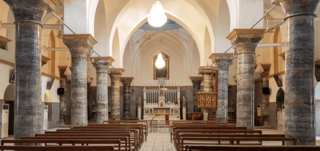
The Chaldean Catholic Church is an Eastern Catholic particular church in full communion with the Holy See and the rest of the Catholic Church, and is headed by the Chaldean Patriarchate. Employing in its liturgy the East Syriac Rite in the Syriac dialect of the Aramaic language, it is part of Syriac Christianity. Headquartered in the Cathedral of Our Lady of Sorrows, Baghdad, Iraq, since 1950, it is headed by the Catholicos-Patriarch Louis Raphaël I Sako. In 2010, it had a membership of 490,371, of whom 310,235 (63.27%) lived in the Middle East.

Joseph VI Audo (1790–1878) was the Patriarch of the Chaldean Catholic Church from 1847 to 1878.
Mar Nicholas I Zaya was the patriarch of the Chaldean Catholic Church from 1839 to 1847. He succeeded Yohannan VIII Hormizd, the last of the Mosul patriarchs who traced their descent from Eliya VI (1558–1591), and his elevation ended four centuries of hereditary succession in the Eliya line. After Zayʿa's accession the Vatican attempted to reform abuses within the Chaldean Church, but its interference was strenuously resisted by several Chaldean bishops. As a result, Zayʿa's short reign was plagued by one crisis after another. In 1846, after the Vatican conspicuously failed to support him against his recalcitrant bishops, he resigned the patriarchate and retired to his native town of Khosrowa, where he died in 1855. He was succeeded by Joseph VI Audo, one of his most determined opponents.
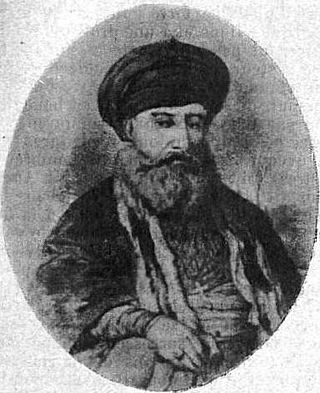
Yohannan VIII Hormizd (1760–1838) was the last hereditary patriarch of the Eliya line of the Church of the East and the first patriarch of a united Chaldean Church. After the death of his uncle Eliya XI in 1778, he claimed the patriarchal throne in 1780 and made a Catholic profession of faith. In 1783, he was recognized by the Vatican as patriarchal administrator and archbishop of Mosul. His career as patriarchal administrator was controversial, and was marked by a series of conflicts with his own bishops and also with the Vatican. Suspended from his functions in 1812 and again in 1818, he was reinstated by the Vatican in 1828. In 1830, following the death of the Amid patriarchal administrator Augustine Hindi, he was recognised by the Vatican as patriarch of Babylon of the Chaldeans and the Mosul and Amid patriarchates were united under his leadership. This event marked the birth of the since unbroken patriarchal line of the Chaldean Catholic Church. Yohannan Hormizd died in 1838 and his successor Nicholas I Zayʿa was chosen by the Vatican, ending the centuries-old practice of hereditary succession.

Shimun VIII Yohannan Sulaqa was the first Patriarch of what was to become the Shemʿon line of Chaldean Catholic Church, from 1553 to 1555, after it absorbed this Church of the East patriarchate into full communion with the Holy See and the Catholic Church.
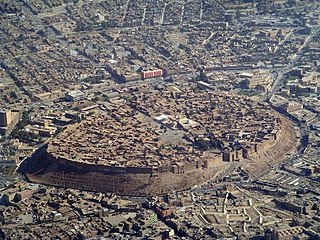
Metropolitanate of Adiabene was an East Syriac metropolitan province of the Church of the East between the 5th and 14th centuries, with more than fifteen known suffragan dioceses at different periods in its history. Although the name Hadyab normally connoted the region around Erbil and Mosul in present-day Iraq, the boundaries of the East Syriac metropolitan province went well beyond the Erbil and Mosul districts. Its known suffragan dioceses included Beth Bgash and Adarbaigan, well to the east of Adiabene proper.
For much of the nineteenth and twentieth centuries the district of Salmas in northwest Iran was an archdiocese of the Chaldean Catholic Church, now a part of the Chaldean Catholic Archeparchy of Urmyā.

The Metropolitanate of Shemsdin, created after the 1552 schism in the Church of the East, the predecessor to the Assyrian Church of the East, was the second most important ecclesiastical province of the Qudshanis patriarchate after the province of the patriarch himself. The metropolitans or matrans of Shemsdin traditionally took the name Hnanishoʿ and lived in the Shemsdin village of Mar Ishoʿin the sub-district of Rustaqa. There were around twelve metropolitans of Shemsdin between the sixteenth and twentieth centuries, most of whom were chosen by hereditary succession. The last metropolitan of Shemsdin, Mar Yosip Khnanisho died in Iraq in 1977, and the office of mutran lapsed on his death.

Dioceses of the Church of the East after 1552 were dioceses of the Church of the East and its subsequent branches, both traditionalist and pro-Catholic.
Diocese of Berwari was an East Syriac diocese of the Church of the East, existing between the 16th and 20th centuries and covering the region of Berwari.
Aqra, properly ʿAqra, was a diocese of the Chaldean Catholic Church founded in the mid-19th century. It was united with the Archeparchy of Mossul to create the Archeparchy of Mossul-Aqra on December 22, 2018.

Chaldean Catholic Eparchy of Seert was a diocese of the Chaldean Catholic Church, centered in Seert. It existed during the eighteenth, nineteenth and early-twentieth centuries. The diocese was ruined during the First World War.
Mardin was a diocese of the Chaldean Church from the sixteenth to the twentieth century. The diocese lapsed in 1941. Prior to this, it was a diocese of the Assyrian Church of the East, from which the Chaldean Catholic Church originated.
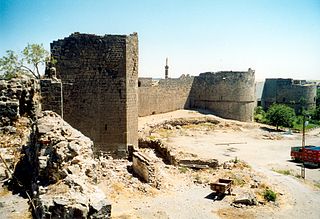
The Diocese of Amid (Diyarbakir) was a diocese or archdiocese of the Chaldean Church from the sixteenth to the twentieth century. From at least the 13th century the city of Amid had been part of the Diocese of Maiperqat of the Church of the East; following the schism of 1552 it became the seat of its own diocese in the Chaldean Church.
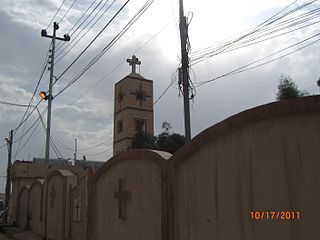
Chaldean Catholic Diocese of Zakho is a diocese of the Chaldean Church in the second half of the 19th century and for most of the 20th century. The diocese of Zakho was merged with the Chaldean diocese of ʿAmadiya in 1987. In December 2001, a new bishop was consecrated. In July 2013, Zakho was suppressed to the Diocese of Amadiyah.
The Chaldean Catholic Archeparchy of Kirkuk is an archeparchy of the Chaldean Catholic Church in communion with the Pope in Rome. The archeparchy was created in the early years of the nineteenth century. Its present ordinary, Archbishop Yousif Thomas Mirkis, was consecrated in 2014.

The patriarch of the Church of the East is the patriarch, or leader and head bishop of the Church of the East. The position dates to the early centuries of Christianity within the Sassanid Empire, and the Church has been known by a variety of names, including the Church of the East, Nestorian Church, the Persian Church, the Sassanid Church, or East Syrian.

Mar Shemʿon VII Ishoʿyahb, born Īshōʿyahb bar Māmā, was Patriarch of the Church of the East from 1539 to 1558, with residence in Rabban Hormizd Monastery.
The schism of 1552 was an important event in the history of the Church of the East. It divided the church into two factions, of which one entered into communion with Rome becoming part of the Catholic Church at this time and the other remained independent until the 19th century. Although the Eliya line, which emerged as a result of this schism, did eventually enter into communion with Rome, various Eastern Protestant sects with their origins in the Church of the East emerged as a result of this schism. The Shimon line whose entry into full communion with Rome caused this schism became independent again by the 17th century. The circumstances of the 1552 schism were controversial at the time and have been disputed ever since.
{{cite book}}: CS1 maint: location missing publisher (link){{cite book}}: CS1 maint: location missing publisher (link){{cite book}}: CS1 maint: location missing publisher (link)